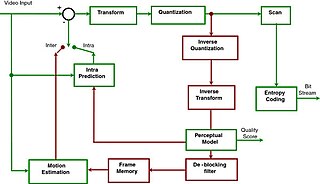Related Research Articles

MPEG-2 is a standard for "the generic coding of moving pictures and associated audio information". It describes a combination of lossy video compression and lossy audio data compression methods, which permit storage and transmission of movies using currently available storage media and transmission bandwidth. While MPEG-2 is not as efficient as newer standards such as H.264/AVC and H.265/HEVC, backwards compatibility with existing hardware and software means it is still widely used, for example in over-the-air digital television broadcasting and in the DVD-Video standard.
Dirac is an open and royalty-free video compression format, specification and software video codec developed by BBC Research & Development. Dirac aimed to provide high-quality video compression for Ultra HDTV and competed with existing formats such as H.264.
Advanced Audio Coding (AAC) is an audio coding standard for lossy digital audio compression. It was designed to be the successor of the MP3 format and generally achieves higher sound quality than MP3 at the same bit rate.

Advanced Video Coding (AVC), also referred to as H.264 or MPEG-4 Part 10, is a video compression standard based on block-oriented, motion-compensated coding. It is by far the most commonly used format for the recording, compression, and distribution of video content, used by 91% of video industry developers as of September 2019. It supports a maximum resolution of 8K UHD.
SMPTE 421, informally known as VC-1, is a video coding format. Most of it was initially developed as Microsoft's proprietary video format Windows Media Video 9 in 2003. With some enhancements including the development of a new Advanced Profile, it was officially approved as a SMPTE standard on April 3, 2006. It was primarily marketed as a lower-complexity competitor to the H.264/MPEG-4 AVC standard. After its development, several companies other than Microsoft asserted that they held patents that applied to the technology, including Panasonic, LG Electronics and Samsung Electronics.
These tables compare features of multimedia container formats, most often used for storing or streaming digital video or digital audio content. To see which multimedia players support which container format, look at comparison of media players.
H.264 and VC-1 are popular video compression standards gaining use in the industry as of 2007.
High Efficiency Video Coding (HEVC), also known as H.265 and MPEG-H Part 2, is a video compression standard designed as part of the MPEG-H project as a successor to the widely used Advanced Video Coding. In comparison to AVC, HEVC offers from 25% to 50% better data compression at the same level of video quality, or substantially improved video quality at the same bit rate. It supports resolutions up to 8192×4320, including 8K UHD, and unlike the primarily 8-bit AVC, HEVC's higher fidelity Main 10 profile has been incorporated into nearly all supporting hardware.
Unified Speech and Audio Coding (USAC) is an audio compression format and codec for both music and speech or any mix of speech and audio using very low bit rates between 12 and 64 kbit/s. It was developed by Moving Picture Experts Group (MPEG) and was published as an international standard ISO/IEC 23003-3 and also as an MPEG-4 Audio Object Type in ISO/IEC 14496-3:2009/Amd 3 in 2012.
A video coding format is a content representation format of digital video content, such as in a data file or bitstream. It typically uses a standardized video compression algorithm, most commonly based on discrete cosine transform (DCT) coding and motion compensation. A specific software, firmware, or hardware implementation capable of compression or decompression in a specific video coding format is called a video codec.
The Alliance for Open Media (AOMedia) is a non-profit industry consortium headquartered in Wakefield, Massachusetts, and formed to develop open, royalty-free technology for multimedia delivery. It uses the ideas and principles of open web standard development to create video standards that can serve as alternatives to the hitherto dominant standards of the Moving Picture Experts Group (MPEG).
AOMedia Video 1 (AV1) is an open, royalty-free video coding format initially designed for video transmissions over the Internet. It was developed as a successor to VP9 by the Alliance for Open Media (AOMedia), a consortium founded in 2015 that includes semiconductor firms, video on demand providers, video content producers, software development companies and web browser vendors. The AV1 bitstream specification includes a reference video codec. In 2018, Facebook conducted testing that approximated real-world conditions, and the AV1 reference encoder achieved 34%, 46.2%, and 50.3% higher data compression than libvpx-vp9, x264 High profile, and x264 Main profile respectively.
Internet Video Coding is a video coding standard. IVC was created by MPEG, and was intended to be a royalty-free video coding standard for use on the Internet, as an alternative to non-free formats such as AVC and HEVC. As such, IVC was designed to only use coding techniques which were not covered by royalty-requiring patents.
Versatile Video Coding (VVC), also known as H.266, ISO/IEC 23090-3, and MPEG-I Part 3, is a video compression standard finalized on 6 July 2020, by the Joint Video Experts Team (JVET), a joint video expert team of the VCEG working group of ITU-T Study Group 16 and the MPEG working group of ISO/IEC JTC 1/SC 29. It is the successor to High Efficiency Video Coding. It was developed with two primary goals – improved compression performance and support for a very broad range of applications.
JPEG XS is an interoperable, visually lossless, low-latency and lightweight image and video coding system used in professional applications. Applications of the standard include streaming high quality content for virtual reality, drones, autonomous vehicles using cameras, gaming, and broadcasting. It was the first ISO codec ever designed for this specific purpose. JPEG XS, built on core technology from both intoPIX and Fraunhofer IIS, is formally standardized as ISO/IEC 21122 by the Joint Photographic Experts Group with the first edition published in 2019. Although not official, the XS acronym was chosen to highlight the eXtra Small and eXtra Speed characteristics of the codec. Today, the JPEG committee is still actively working on further improvements to XS, with the second edition scheduled for publication and initial efforts being launched towards a third edition.

V-NOVA is a multinational IP and Technology company headquartered in London, UK. It is best known for innovation in data compression technology for video and images. V-Nova has partnered with large organizations including Sky, Xilinx, Nvidia, Eutelsat, and Amazon Web Services to provide its video compression technology.

SMPTE ST 2117-1, informally known as VC-6, is a video coding format.

Low Complexity Enhancement Video Coding (LCEVC) is a ISO/IEC video coding standard developed by the Moving Picture Experts Group (MPEG) under the project name MPEG-5 Part 2 LCEVC.
References
- ↑ Pennington, Adrian (6 April 2019). "NAB 2019: Five trends to watch". IBC . Retrieved 6 April 2019.
- 1 2 Timmerer, Christian (14 February 2019). "MPEG 125 Meeting Report". Bitmovin . Retrieved 6 April 2019.
- 1 2 Gibellino, Diego (4 March 2019). "Introducing MPEG-5" . Retrieved 6 April 2019.
- ↑ "MPEG-5 EVC gets final approval". CSImagazine.com. Retrieved 6 May 2020.
- 1 2 "Requirements for a New Video Coding Standard". 12 October 2018. Retrieved 6 April 2019.
- ↑ Chiariglione, Leonardo (28 January 2018). "A crisis, the causes and a solution" . Retrieved 6 April 2019.
I saw the danger coming and designed a strategy for it. This would create two tracks in MPEG: one track producing royalty free standards (Option 1, in ISO language) and the other the traditional Fair Reasonable and Non Discriminatory (FRAND) standards (Option 2, in ISO language).
- 1 2 3 Samuelsson, Jonatan; Choi, Kiho; Chen, Jianle; Rusanovskyy, Dmytro (2020). "MPEG-5 Part 1: Essential Video Coding". SMPTE Motion Imaging Journal. 129 (7). SMPTE: 10–16. doi:10.5594/JMI.2020.3001795. S2CID 225463271 . Retrieved 26 June 2021.
- ↑ Ozer, Jan (October 15, 2019). "Inside MPEG's Ambitious Plan to Launch 3 Video Codecs in 2020" . Retrieved June 12, 2020.
Though the EVC Main profile uses royalty-bearing "tools," these can be switched on and off with "limited loss of performance." This was the model deployed by Divideon and their xvc codec, and, in theory, it allows those deploying the technology to pick and choose both the performance and the associated royalty cost. (…) Two proposals were submitted in response to MPEG's call for proposals for MPEG-5 Part 1, and MPEG selected the proposal from Samsung, Huawei, and Qualcomm
- ↑ "eXtra-fast Essential Video Encoder (XEVE)". January 9, 2023 – via GitHub.
- ↑ "AI-Enhanced Video Coding (MPAI-EVC)". Moving Picture, Audio and data Coding by Artificial Intelligence.
- ↑ "Basic Applications, Technologies and Benefits for Video Coding by means of Artificial Intelligence". mpai.community/news/presentations/#ShortPresentation. 23 February 2021. Retrieved 21 September 2022.
- ↑ "Video Basic Applications, Technologies and Benefits for Video Coding by means of Artificial Intelligence". mpai.community/news/presentations/#ShortPresentation. 23 February 2021. Retrieved 21 September 2022.